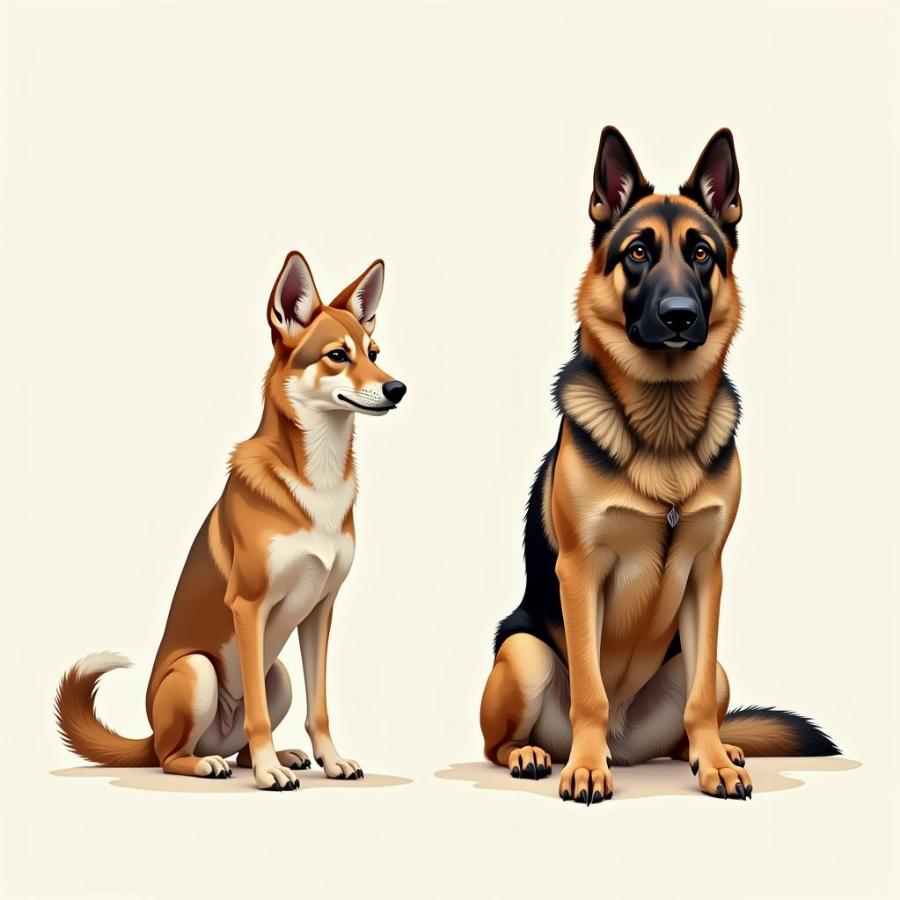Coy dog vs coyote – a question often sparking curiosity among nature enthusiasts and dog lovers alike. While the names sound similar, these canids are distinct creatures with unique characteristics and roles in the ecosystem. Understanding the differences between a coy dog and a coyote is crucial not only for appreciating the diversity of wildlife but also for responsible pet ownership and ensuring the safety of both animals and humans.
Physical Characteristics: Spotting the Difference Between Coy Dog and Coyote
Coy dogs, as the name suggests, are hybrids resulting from the mating of coyotes and domestic dogs. Their appearance can vary widely, depending on the breed of dog involved in the mix. They often inherit the coyote’s wiry build, pointed ears, and bushy tail, but their coat color and size can fluctuate. Coyotes, on the other hand, typically display a more uniform appearance. They boast a tawny-grey coat, a long bushy tail with a black tip, and erect, pointed ears.
Size and Weight: A Key Differentiator
Coyotes are generally larger than coy dogs, although size can overlap depending on the dog breed in the hybrid mix. Adult coyotes can weigh between 20-50 pounds, while coy dogs typically range from 25-45 pounds. However, a coy dog with a larger dog breed in its lineage might exceed the average coyote size.
 So sánh kích thước chó sói đồng cỏ và chó sói
So sánh kích thước chó sói đồng cỏ và chó sói
Habitat and Distribution: Where Coy Dogs and Coyotes Roam
Coyotes have a remarkably adaptable nature and can thrive in a variety of habitats, from forests and grasslands to urban areas. Their range extends across North and Central America, demonstrating their resilience and adaptability. Coy dogs, due to their hybrid origin, are often found in areas where both coyotes and domestic dogs co-exist. Their distribution is less well-defined than that of coyotes, as it depends on the opportunities for interbreeding.
Urban Encounters: Navigating Coyote and Coy Dog Interactions in Cities
With increasing urbanization, encounters with coyotes, and potentially coy dogs, are becoming more common in cities. Understanding their behavior in these settings is critical for peaceful coexistence. coyote vs dog tracks can sometimes be confusing.
Behavior and Social Dynamics: A Look into their World
Coyotes are highly social animals, living in family groups called packs. They communicate through a complex system of howls, yips, and barks. Coy dogs, on the other hand, exhibit more variable social behavior, which can be influenced by the domestic dog parentage. Some may display pack-like tendencies, while others might be more solitary. Their vocalizations can also differ, blending coyote calls with dog barks. coyote vs dog interactions can be complex.
Diet and Hunting: What’s on the Menu?
Both coyotes and coy dogs are opportunistic omnivores, consuming a variety of food sources. Coyotes primarily prey on small mammals like rabbits and rodents, but also supplement their diet with fruits, insects, and occasionally carrion. Coy dogs share a similar diet, although their scavenging habits might be more pronounced due to the influence of domestic dog behavior. coyotes vs dogs sometimes compete for resources.
Conclusion: Appreciating the Distinct Nature of Coy Dogs and Coyotes
Understanding the differences between coy dogs and coyotes is paramount for both wildlife conservation and responsible pet ownership. By recognizing their distinct physical traits, habitat preferences, and behavioral patterns, we can better appreciate their unique roles in the ecosystem and promote peaceful coexistence. The coy dog vs coyote question highlights the fascinating interplay between wild and domestic animals and underscores the importance of ongoing research and education.
FAQ: Addressing Common Questions about Coy Dogs and Coyotes
- Are coy dogs dangerous? Coy dogs can pose a potential threat due to their unpredictable nature, inheriting traits from both coyotes and domestic dogs.
- How can I tell the difference between coyote and dog tracks? Coyote tracks are typically more elongated and have a more distinct “X” pattern between the toe pads.
- Do coy dogs breed with domestic dogs? Yes, coy dogs can breed with both domestic dogs and coyotes, further complicating the genetic mix.
- What should I do if I encounter a coyote or coy dog? Avoid approaching the animal, make yourself appear larger, and make loud noises to scare it away.
- Are coyotes protected? Coyote protection status varies depending on location and local regulations.
- What do coyotes eat? Coyotes are opportunistic omnivores, eating small mammals, fruits, insects, and carrion.
- How do coy dogs impact the ecosystem? The impact of coy dogs on the ecosystem is still being studied, but their presence can influence prey populations and potentially introduce diseases.
Beaut Dogs is your go-to source for all things related to dog breeds, care, and understanding canine companions. For further assistance, contact us via Email: [email protected] to receive detailed and accurate answers from our experts at Beaut Dogs (https://beautdogs.com).